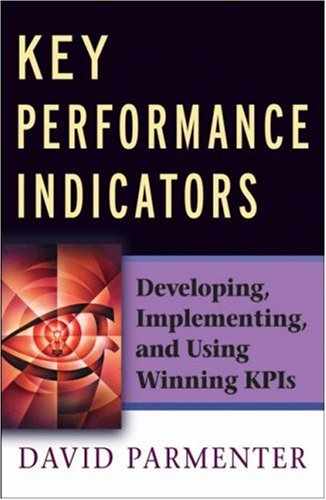0%
10Chapters
0-1Hours read
0kTotal Words
Book Description
Breathtaking in its simplicity and profound in its impact, Key Performance Indicators (KPI) distills the balanced scorecard process into twelve logical steps, equipping users with an implementation resource kit that includes questionnaires, worksheets, workshop outlines, and a list of over 500 performance measures. Author David Parmenter provides you with everything you need to master and implement a KPI-driven strategy.
Table of Contents
- Copyright
- Preface
- Embarking on a KPI/Balanced Scorecard Project
- How to Use This Book
- Using Chapter 1: Introduction
- Using Chapter 2: Foundation Stones for Implementing Key Performance Indicators
- Using Chapter 3: Developing and Using KPIs: A 12-Step Model
- Using Chapter 4: KPI Team Resource Kit
- Using Chapter 5: Templates for Reporting Performance Measures
- Using Chapter 6: Facilitator’s Resource Kit
- Using the Appendix: Performance Measures Database
- Endnote
- Embarking on a KPI/Balanced Scorecard Project
- Acknowledgments
- 1. Introduction
- 2. Foundation Stones for Implementing Key Performance Indicators
- Four Foundaton Stones Guiding the Development and Use of KPIs
- Defining Vision, Mission, and Strategy
- How to Implement Winning KPIs in 16 Weeks
- Lesson 1: Appoint an External Project Facilitator
- Lesson 2: Begin with the Senior Management Team: Commitment and Education
- Lesson 3: Focus on the Critical Success Factors
- Lesson 4: Follow the 10/80/10 Rule
- Lesson 5: Select a Small KPI Team
- Lesson 6: “Just Do It”
- Lesson 7: Use Existing Systems for the First 12 Months
- Lesson 8: Trap All Performance Measures in a Database and Make Them Available to All Teams
- Lesson 9: KPI Reporting Formats Are an “Art Form, Not a Science”
- Lesson 10: Maybe You Need to Rename
- Endnotes
- 3. Developing and Using KPIs: A 12-Step Model
- Step 1: Senior Management Team Commitment
- Step 2: Establishing a “Winning KPI” Project Team
- Step 3: Establishing a “Just Do It” Culture and Process
- Step 4: Setting Up a Holistic KPI Development Strategy
- Step 5: Marketing the KPI System to all Employees
- Step 6: Identifying Organization-Wide Critical Success Factors
- Step 7: Recording Performance Measures in a Database
- Step 8: Selecting Team-Level Performance Measures
- Step 9: Selecting Organizational “Winning KPIS”
- Step 10: Developing the Reporting Framework at All Levels
- Step 11: Facilitating the Use of Winning KPIS
- Step 12: Refining KPIs to Maintain their Relevance
- Endnotes
- 4. KPI Team Resource Kit
- Using This Resource KIT
- Step 1 Worksheet: Senior Management Team Commitment
- Step 2 Worksheet: Establishing a Winning KPI Team
- Step 3 Worksheet: Establish a “Just Do It” Culture for This Project
- Step 4 Worksheet: Setting Up a Holistic KPI Development Strategy
- Step 5 Worksheet: Marketing the KPI System to All Employees
- Step 6 Worksheet: Identifying Organization-Wide CSFs
- Step 7 Worksheet: Comprehensive Recording of Measures within the Database
- Step 8 Worksheet: Selecting Team Performance Measures
- Step 9 Worksheet: Selecting Organization-Wide “Winning KPIs”
- Step 10 Worksheet: Developing Display, Reporting, and Review Frameworks at All Levels
- Step 11 Worksheet: Facilitating the Use of KPIs
- Step 12 Worksheet: Refining and Modifying KPIs to Maintain Their Relevance
- 5. Templates for Reporting Performance Measures
- 6. Facilitator’s Resource Kit
- Performance Measures Database
